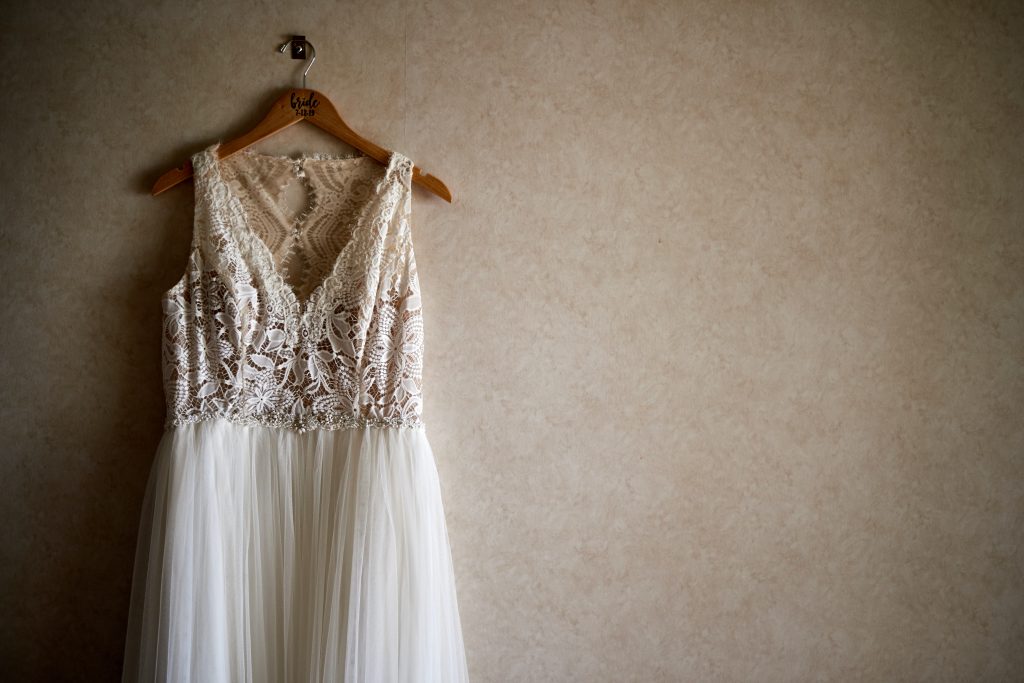Your wedding dress is more than just a piece of clothing—it’s a symbol of one of the most important days of your life. Whether you want to keep it as a cherished keepsake or pass it down through generations, preserving it properly is crucial to ensure it stays in pristine condition. While many brides turn to professionals for wedding dress preservation, it’s also possible to do it yourself with the right knowledge and tools. In this guide, I’ll walk you through the key steps of preserving your wedding dress at home, including tips, materials, and expert advice.
Why Preserve Your Wedding Dress? The Sentimental Value & Practical Benefits
How Preserving Your Wedding Dress Protects Your Memories
As someone who’s worked with countless couples over the years, I’ve seen just how much sentimental value a wedding dress holds. It’s not just a garment—it represents the beginning of a new chapter, and it’s filled with memories of one of the most important days of your life. Many of my clients have chosen to preserve their wedding dresses, either as a family heirloom or as a keepsake to remind them of that special day.
But here’s the thing: wedding dresses, if not properly preserved, can lose their beauty and significance. Over time, they can fade, yellow, or deteriorate. Proper preservation helps maintain the integrity of the fabric and keeps the memories tied to it alive. I always advise my clients to act soon after the wedding to preserve their dresses properly, as it ensures they last for years—if not generations—to come.
The Risks of Not Preserving Your Wedding Dress
I’ve seen what happens when wedding dresses aren’t preserved properly, and it’s not pretty. One of my clients assumed she could just hang her wedding dress in a regular garment bag in her closet, and months later, she noticed that the delicate fabric had yellowed and started to show signs of wear. That’s the harsh reality—wedding dresses need special care if you want to keep them looking their best.
If you skip the preservation process, your wedding dress is vulnerable to:
- Yellowing: Stains from sweat or food can cause yellow patches that worsen with time.
- Mould & Mildew: In humid environments, improperly stored dresses can easily develop mould and mildew.
- Creases & Tears: If the dress is stored improperly, the weight of the fabric can cause creases, or in some cases, it may even tear.
Preserving your wedding dress as soon as possible is crucial for ensuring that it stays in the best possible condition for years to come.
DIY Wedding Dress Preservation: Is It Worth The Effort?
Can You Really Preserve Your Wedding Dress Yourself?
This is the question I get asked most often: Can I preserve my wedding dress myself? The short answer is yes. However, there are some important things to consider before you dive into a DIY preservation project.
I’ve helped many couples preserve their wedding dresses themselves, and while it can be a great option, it’s not for everyone. DIY preservation can be cost-effective, but it requires a significant amount of patience, care, and knowledge. The process isn’t as simple as it might seem, and if you don’t follow the right steps or use the proper materials, you could risk damaging the dress irreparably. I’ve seen dresses that were ruined because people tried to clean them with the wrong products or used incorrect storage methods.
If you’re up for the challenge, DIY preservation is possible—but you need to be meticulous. I always tell my clients that, while the effort can be rewarding, it’s also important to know your limitations. If you don’t have the time or confidence, it’s always best to leave it to the professionals.
Why Professional Preservation Is Often the Safer Option
While DIY preservation can be a great option for some, I always recommend professional preservation to my clients who are looking for peace of mind. There’s a reason professionals exist—they have the tools, expertise, and knowledge to handle the delicate nature of wedding dresses. From using the right materials to employing the proper cleaning techniques, professionals ensure your dress is preserved properly and stays in perfect condition for the long term.
I remember working with a couple who had invested quite a bit in their wedding dress, and they wanted to preserve it for future generations. They chose professional preservation, and the results were amazing. The dress looked as pristine as the day they wore it. The professional service used special techniques, like applying acid-free tissue paper and storing the dress in a high-quality preservation box. They even offered a guarantee that the dress wouldn’t yellow over time. For those who want to make sure their wedding dress is taken care of without the hassle or risk of DIY, professional preservation is the way to go.
Key Steps for DIY Wedding Dress Preservation at Home
Step 1 – Cleaning Your Wedding Dress After the Big Day
One of the first things I always advise my clients is to clean the dress as soon as possible after the wedding. The longer you wait, the harder it becomes to remove stains, and you might end up with set-in marks that could be difficult or even impossible to get rid of. Ideally, cleaning should be done within 1-2 days of the wedding. After all, the last thing you want is to leave food stains, makeup smudges, or dirt from the ceremony untreated for too long.
When I preserved my own wedding dress, I made sure to treat the hemline, which had picked up dirt from the floor during the day. If you’ve noticed any visible stains, it’s important to address them right away. I remember using a gentle, pH-neutral cleaner and applying it carefully with a soft brush. Avoid using harsh chemicals or bleach—those can cause irreversible damage to the fabric. And definitely don’t scrub too hard, especially if the fabric is delicate.
Spot-testing the cleaner in a hidden area of the dress first is always a good idea to make sure it won’t cause any damage. Taking the time to clean the dress properly ensures that it won’t get worse over time. Even if you’re not planning to preserve the dress right away, a quick clean after the wedding day is essential.
Step 2 – Proper Handling and Care During the Cleaning Process
Once you’ve tackled the stains, it’s time to handle the dress carefully. I can’t stress enough how important it is to wear clean, white cotton gloves when handling your wedding dress. The oils from your hands can transfer onto the fabric, leaving marks that are hard to remove later. I learned this lesson the hard way, and now I always recommend gloves to anyone who asks for preservation advice.
As you clean the dress, be gentle, especially around embellishments. Use a soft-bristled brush to gently work on dirt and stains, but avoid brushing any beading or delicate details. If you’re unsure, I always recommend focusing on the fabric itself first and using a more targeted approach for the intricate parts. The last thing you want is to damage any embroidery or delicate lace.
Step 3 – Drying and Inspecting Your Dress
Once the dress is clean, make sure it’s completely dry before you store it away. If you store the dress while it’s still damp, it can develop mildew or mould. After my own experience, I learned that air-drying is the best option. I hung my dress in a cool, dry room, away from direct sunlight. I also turned it inside out to protect any delicate outer layers.
While the dress is drying, take this time to inspect it for any remaining stains, areas that need extra attention, or possible tears that could have occurred during the ceremony. Make sure the fabric is in its best condition before proceeding to the next step.
Preserving Your Wedding Dress: The Materials and Techniques
Using Acid-Free Materials to Protect Your Gown
One of the most important things I always remind my clients about is the need to use acid-free materials for preservation. Acid-free tissue paper is crucial for preventing yellowing, discolouration, or fabric deterioration over time. I still remember the first time I preserved my own wedding dress—I used regular tissue paper, and within a year, I could see faint marks where the paper had come into contact with the fabric. That mistake taught me just how vital it is to use the right materials.
You’ll also want to invest in an acid-free preservation box or a breathable garment bag. These materials help protect your dress from moisture, dust, and other environmental factors that can cause damage. I’ve worked with several brides who initially tried to save a few dollars by using plastic bags or regular boxes. Trust me, those items trap moisture and lead to mould or mildew. They can also cause yellowing over time due to the acidity in the materials. I always suggest a high-quality, archival box or breathable muslin garment bag instead.
Step-by-Step Guide to Packing Your Wedding Dress for Preservation
Once your dress is clean and dry, it’s time to wrap and store it. I suggest wrapping the dress in acid-free tissue paper, especially around the bodice and sleeves, to avoid any creasing. I learned the hard way that it’s important to avoid folding the dress along the same lines each time. Repeated folding can lead to permanent creases in the fabric. To avoid this, I recommend refolding the dress periodically, creating new fold lines.
For the bust and sleeves, I suggest gently stuffing the areas with more acid-free tissue paper to help maintain their shape. This can help prevent any sagging or misshaping over time. When packing, ensure that the box is just the right size—not too tight and not too loose. A snug fit ensures the dress stays in place and is less likely to shift or get damaged.
Storage Ideas: Where and How to Store Your Preserved Wedding Dress
Choosing the Best Storage Location
Once your wedding dress is properly preserved, the next crucial step is choosing the best storage location. You want to store your dress in a cool, dry, and dark place—ideally a climate-controlled space like a closet. I always advise my clients to avoid places that are prone to temperature fluctuations, such as attics or basements, where moisture can quickly wreak havoc on fabric.
A closet in a bedroom or guest room is usually ideal. The key is to avoid direct sunlight or artificial lighting, as this can cause fading and discolouration over time. A closet that’s not too damp and free from pests is the perfect environment for long-term storage. I also recommend keeping the dress off the floor, as contact with the ground can introduce dust and dirt, as well as increase the risk of mould.
DIY Wedding Dress Packaging: Best Practices for Long-Term Storage
While some brides opt to hang their wedding dress, I always recommend flat storage when possible. Storing the dress flat reduces the pressure on the fabric and minimises the risk of permanent creases or sagging. I’ve worked with several clients who used a padded hanger and a breathable garment bag to hang their dress. While this method works in some cases, it’s important to ensure that the hanger doesn’t distort the shape of the dress, especially if it’s heavy or made from delicate materials.
I always advise using an archival-quality storage box that’s large enough to allow the dress to lie flat without cramming it inside. This way, there’s less risk of damaging the fabric. Make sure you check on the dress every few years to ensure it’s holding up well. If you’ve chosen a professional preservation service, they often provide inspection tips or schedules.
The Pros and Cons of DIY Wedding Dress Preservation
DIY Preservation: Cost-Effective But Risky
One of the biggest reasons brides consider DIY wedding dress preservation is the potential cost savings. Professional services can range anywhere from $200 to $500, depending on the complexity of the dress and any additional services you might need. DIY preservation, on the other hand, can cost much less, especially if you already have some of the necessary materials. However, while DIY can save you money upfront, there are a few risks you need to consider.
I’ve worked with couples who were drawn to DIY because they thought it would be cheaper, only to realise they hadn’t fully considered the risk of damaging their wedding dress. If you don’t use the right materials or follow the correct procedures, you could inadvertently ruin your dress. For instance, using the wrong cleaning products or storing it in an improper container can result in stains, mildew, or yellowing. And, of course, fixing these issues can be expensive or, worse, impossible.
The key here is to weigh the emotional and financial value of your wedding dress. If it’s something you hold dear and want to pass down or preserve for the long term, the small cost of professional preservation could be well worth it. However, if you’re comfortable handling the process yourself, with the right knowledge and materials, DIY can certainly be a viable option.
When to Consider Professional Preservation
As much as DIY can be tempting, I always advise clients to consider professional preservation if they’re uncertain about their ability to follow the right procedures. The peace of mind that comes with knowing an expert is taking care of your dress is invaluable. I remember a couple who had spent a lot of money on a custom-made wedding dress. They initially thought they’d preserve it themselves but eventually opted for professional preservation, and I could see the relief in their eyes knowing it was being taken care of by experts. The service they chose offered a guarantee against yellowing and offered to check on the dress every few years.
If you’re dealing with an heirloom-quality dress or one with intricate details, professional preservation can help prevent long-term damage. Professional services also use high-quality, acid-free materials and storage solutions, which are much more reliable than standard DIY options.
For those who want the most secure, long-lasting solution for preserving their wedding dress, professional services are the best way to go. They provide an extra layer of protection, and the guarantee against future damage is a huge advantage.
Preserving Your Wedding Dress for the Future
Actionable Tips for Safe and Effective DIY Preservation
If you’ve decided to take on the task of preserving your wedding dress yourself, here are a few actionable tips that will help you get the best results:
- Clean the dress immediately: Try to clean your wedding dress as soon as possible after the wedding to prevent stains from setting.
- Use the right materials: Invest in acid-free tissue paper, preservation boxes, and garment bags. Avoid plastic or cardboard that can harm the fabric.
- Be gentle: Handle the dress carefully, using gloves and soft brushes. When in doubt, be extra gentle.
- Store it in a cool, dry place: Keep the dress in a climate-controlled space, away from sunlight, moisture, and heat.
By following these steps, you’ll increase the likelihood of preserving your dress for many years to come. But remember, preserving a wedding dress is an art in itself, so take your time and be patient with the process.
Let’s Get Straight to the Point
Preserving your wedding dress is essential to maintain its beauty and sentimental value for years to come. While professional preservation offers peace of mind, DIY preservation is also possible with the right tools and techniques. Start by cleaning the dress soon after the wedding, using gentle, pH-neutral cleaners. Be sure to handle the dress carefully, wearing gloves, and store it in acid-free materials like tissue paper and a preservation box. Choose a cool, dry, dark location for storage, and check on the dress periodically to ensure it’s in good condition. The choice between DIY and professional preservation depends on your comfort level and the value of your dress.




